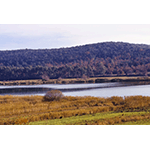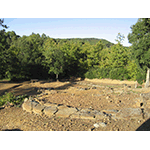Parco Archeologico del Lago dell'Accesa ["Lago dell'Accesa" Archaeological Park]
In the midst of a dense woodland area near the Lago dell’Accesa, lie the remains of an ancient Etruscan town, which is still being excavated. The settlement, divided into quarters, was one of a series of small towns in the 6th century B.C. in the area of influence of Vetulonia, sited along itineraries tied to mining activities in the area. The dell’Accesa area is outstanding for having yielded copious evidence of what is today acknowledged as one of the few known urban centres of Etruria.
The chronology of the explored quarters ranges from the late 7th to the 6th century B.C., but the tombs discovered in the area testify to its occupation at least as of the late 9th century B.C.
It is doubtlessly quarter C to hold the greatest interest from the technological point of view. Begun in the first half of the 6th century B.C., it stands out from the others for the presence, on the eastern side, of two groups of furnaces for working metals. Today we can see the craters with concave profile where piles of stones and bricks (with evident signs of exposure to heat) were heaped, mixed with pieces of mineral and a great deal of smelting slag. It appears as no coincidence that the quarter most connoted for handicrafts was also the one closest to the lake: the availability of water was indeed indispensable for the operations of metalworking. The very location of the furnaces, disposed on the border of the inhabited area, would seem to respond to the dictates of the Etrusca disciplina, recalled by Vitruvius in the De architectura (I, 7,1), whereby the areas destined to metallurgical activity had to lie outside of the urban area to avoid the risks of fire.
The buildings brought to light show their foundations formed by local stones such as sandstone or palombino, while the elevations made of unfired bricks, trellises (interlaced branches and reeds, covered with clay) or pisť (fresh clay cast into formwork, which was later removed) have been lost.
Particularly interesting are the technical solutions adopted for water drainage: in addition to the stone ballasts with a honeycomb function, also remarkable is the system of covered raceways, an example of which has survived in house VI of quarter C.
Today a theme park of the Etruscan civilisation, the town can be easily visited with the help of numerous explanatory panels distributed along the itinerary that winds through an uncontaminated nature. An indispensable complement to an outing at the "Lago dell’Accesa" Park is a visit to the Archaeological Museum of Massa Marittima, which exhibits finds discovered in the course of almost a century of excavations.
****************************
Texts by Elena Fani
English translation by Victor Beard
Last update 12/mar/2008





